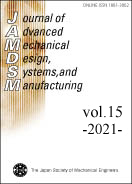15 巻, 6 号
選択された号の論文の13件中1~13を表示しています
- |<
- <
- 1
- >
- >|
Papers
-
2021 年 15 巻 6 号 p. JAMDSM0065
発行日: 2021年
公開日: 2021/10/07
PDF形式でダウンロード (2233K) -
2021 年 15 巻 6 号 p. JAMDSM0066
発行日: 2021年
公開日: 2021/10/07
PDF形式でダウンロード (1614K) -
2021 年 15 巻 6 号 p. JAMDSM0067
発行日: 2021年
公開日: 2021/10/08
PDF形式でダウンロード (2297K) -
2021 年 15 巻 6 号 p. JAMDSM0068
発行日: 2021年
公開日: 2021/10/08
PDF形式でダウンロード (4270K) -
2021 年 15 巻 6 号 p. JAMDSM0069
発行日: 2021年
公開日: 2021/10/15
PDF形式でダウンロード (1684K) -
2021 年 15 巻 6 号 p. JAMDSM0070
発行日: 2021年
公開日: 2021/10/19
PDF形式でダウンロード (1799K) -
2021 年 15 巻 6 号 p. JAMDSM0071
発行日: 2021年
公開日: 2021/10/23
PDF形式でダウンロード (2642K) -
2021 年 15 巻 6 号 p. JAMDSM0072
発行日: 2021年
公開日: 2021/10/29
PDF形式でダウンロード (2155K) -
2021 年 15 巻 6 号 p. JAMDSM0073
発行日: 2021年
公開日: 2021/10/29
PDF形式でダウンロード (1361K) -
2021 年 15 巻 6 号 p. JAMDSM0074
発行日: 2021年
公開日: 2021/11/05
PDF形式でダウンロード (1694K) -
2021 年 15 巻 6 号 p. JAMDSM0075
発行日: 2021年
公開日: 2021/11/11
PDF形式でダウンロード (3483K) -
2021 年 15 巻 6 号 p. JAMDSM0076
発行日: 2021年
公開日: 2021/11/13
PDF形式でダウンロード (1722K) -
2021 年 15 巻 6 号 p. JAMDSM0077
発行日: 2021年
公開日: 2021/11/18
PDF形式でダウンロード (1832K)
- |<
- <
- 1
- >
- >|
